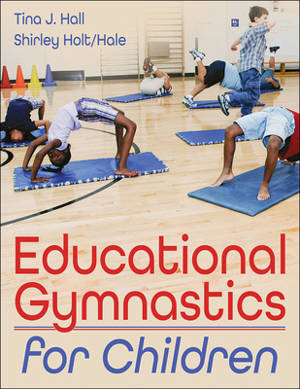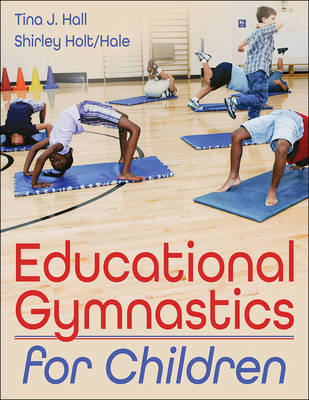
- Afhalen na 1 uur in een winkel met voorraad
- Gratis thuislevering in België vanaf € 30
- Ruim aanbod met 7 miljoen producten
- Afhalen na 1 uur in een winkel met voorraad
- Gratis thuislevering in België vanaf € 30
- Ruim aanbod met 7 miljoen producten
Zoeken
€ 75,45
+ 150 punten
Omschrijving
Educational gymnastics is a field that differs from traditional gymnastics. Instead of a focus on developing skills in which all students are expected to develop at the same rate, educational gymnastics provides learning experiences that are designed to meet children at their skill level and expand skills within their level of competence. Educational gymnastics centers on balance as a lifelong skill, on self-responsibility, and on respect for self and others. Educational Gymnastics for Children takes a child-centered approach to offering highly applied and safe learning experiences as it provides readers with the theoretical foundation and practical application of educational gymnastics for all elementary students. Written by two physical education professionals who have years of experience providing these learning experiences to children in elementary physical education programs, the text offers the following:
The learning experiences in the text are presented as a progression based on the development of children, both physically and cognitively. Each series of learning experiences is preceded by a cognitive focus, a skill focus, criteria for quality, and information on safety, equipment, and organization to maximize participation and learning. Teaching tips are offered throughout to help teachers develop lesson plans to fit the needs of their students. Organization
Educational Gymnastics for Children is organized into three parts. Part I presents the theoretical background for educational gymnastics, comparing it to traditional gymnastics. This part explains how educational gymnastics meets children at their skill level and expands their skills within their level of competence. The components of balance are explored, and these chapters explain how to create a learning environment that is student centered, success oriented, and safe. Part II presents learning experiences that will help children develop a functional understanding of the components of educational gymnastics. This part explores the skills of balance, weight transfer, and travel. It offers individual and partner sequences, both with and without equipment. Part III addresses two vital questions for teachers: What is your goal for the children you teach? How do you know they have accomplished that goal? Standards and assessments are examined in this part. Lifelong Skills
Educational Gymnastics for Children provides teachers with the content and teaching strategies they need to provide students a quality program of educational gymnastics--and to acquire some lifelong skills along the way.
- Gymnastics learning experiences for elementary physical education, most requiring no gymnastics equipment
- Detailed safety measures for all learning experiences to ensure a safe environment
- Assessment strategies to enhance student learning
- A child-centered approach to engage all students in a noncompetitive environment that encourages variety in student response and success for all students, thus fostering social-emotional learning and self-worth
The learning experiences in the text are presented as a progression based on the development of children, both physically and cognitively. Each series of learning experiences is preceded by a cognitive focus, a skill focus, criteria for quality, and information on safety, equipment, and organization to maximize participation and learning. Teaching tips are offered throughout to help teachers develop lesson plans to fit the needs of their students. Organization
Educational Gymnastics for Children is organized into three parts. Part I presents the theoretical background for educational gymnastics, comparing it to traditional gymnastics. This part explains how educational gymnastics meets children at their skill level and expands their skills within their level of competence. The components of balance are explored, and these chapters explain how to create a learning environment that is student centered, success oriented, and safe. Part II presents learning experiences that will help children develop a functional understanding of the components of educational gymnastics. This part explores the skills of balance, weight transfer, and travel. It offers individual and partner sequences, both with and without equipment. Part III addresses two vital questions for teachers: What is your goal for the children you teach? How do you know they have accomplished that goal? Standards and assessments are examined in this part. Lifelong Skills
Educational Gymnastics for Children provides teachers with the content and teaching strategies they need to provide students a quality program of educational gymnastics--and to acquire some lifelong skills along the way.
Specificaties
Betrokkenen
- Auteur(s):
- Uitgeverij:
Inhoud
- Aantal bladzijden:
- 200
- Taal:
- Engels
Eigenschappen
- Productcode (EAN):
- 9781718212008
- Verschijningsdatum:
- 2/08/2023
- Uitvoering:
- Paperback
- Formaat:
- Trade paperback (VS)
- Gewicht:
- 566 g

Alleen bij Standaard Boekhandel
+ 150 punten op je klantenkaart van Standaard Boekhandel
Beoordelingen
We publiceren alleen reviews die voldoen aan de voorwaarden voor reviews. Bekijk onze voorwaarden voor reviews.











